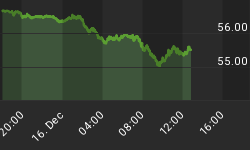Worst January Since 2010

The trend of disappointing earnings continued Friday, adding to concerns about the economy's ability to step up as the Fed tries to step back. From Bloomberg:
U.S. stocks sank, with the Standard & Poor's 500 Index headed for its worst January since 2010, as earnings reports at companies from Amazon to Mattel Inc. disappointed investors. Amazon slumped almost 9 percent after the world's largest Web retailer reported profit and sales that trailed analysts' estimates. Mattel Inc. sank 9.5 percent after a drop in Barbie sales weighed on results. Wal-Mart Stores Inc. fluctuated after saying profit will be at or below the low end of its previous forecast as winter storms and lower food-stamp benefits hurt U.S. sales.
Deflationary Concerns Create Demand For Bonds

The longer you study markets the clearer it becomes that stock market corrections and bear markets are deflationary events, driven by fear of slowing or contracting economies. Deflation is a term that is beginning to surface again. From MarketWatch:
Deflation fears have taken a firm grip on Europe. Inflation data for the currency union released Friday showed an unexpected fall in January to 0.7%. As analysts had forecast no change at 0.8% or slight increase to 0.9%, the disappointing data could push the European Central Bank to try further easing measures in the next six months. After all, just like the Federal Reserve's Ben Bernanke, the ECB's Mario Draghi and his fellow policy makers are mindful of how damaging Japan's long period of deflation was to its economy and employment. As Christine Lagarde, managing director of the International Monetary Fund, said earlier in January: "If inflation is the genie, then deflation is the ogre that must be fought decisively."
If you are unfamiliar with the deflation case history of the Land of The Rising Sun, Japan's struggle with deflation was outlined on December 4, 2013. If central banks are less apt to raise interest rates when deflation remains a concern, then bonds become more attractive. Last week, we made the case for adding bonds to our portfolio mix. Is demand increasing for bonds relative to stocks? Yes, as shown in the chart below. The look of the chart, as of Friday afternoon, was different than anything that occurred in 2013, meaning we are seeing a possible and important shift in the markets.

Investors Trimming Around The Margins
Often when developed economies have struggled in recent years, emerging market economies provided a source of optimism and support. That is not the case currently. From The Wall Street Journal:
The moves came after the selloff in emerging markets continued to spread Friday, biting currencies in Europe that before this week had been resilient. That has prompted U.S. stock investors to shy away from taking risks, a sharp turn from the bullish sentiment that drove the S&P 500 and Dow to records last year, traders said. Investors are also wary of the ripple effects as the U.S. Federal Reserve scales back a monetary-stimulus program that had sent cash surging into global markets."Now that the Fed is truly getting out of the way, everybody's trying to get back to evaluating all asset classes on fundamentals," said Keith Bliss, senior vice president at New York brokerage Cuttone & Co. "Investors are trimming around the margins. I don't sense there's a buy-the-dip crowd coming in yet."
Investment Implications - Three Basic Scenarios To Prepare For
As of 2:00 p.m. EST Friday, the S&P 500 continued to leave the head-and-shoulders scenario outlined January 28 on the table.

Conviction remains tepid in the bullish camp and in the bearish camp, meaning the market could still go either way over the next few weeks. There are three major scenarios that we must feel comfortable responding to:
- A break of 1,767-1,770ish on the S&P 500, followed by another leg down in stocks.
- The head-and-shoulders scenario calls for a rally, but one that fails to make a new high (stays below 1,851ish).
- The most bullish scenario calls for a push toward 1,882 or 1,916.
Since our approach avoids forecasting and instead calls for observation, flexibility, and incremental adjustments, we can adjust our allocations under all three scenarios. As of late in Friday's session, we continued to hold a portfolio that aligns with an indecisive market; U.S. stocks (SPY), technology (QQQ), bonds (TLT), and cash. In terms of which way to migrate, the market will guide us if we are willing to listen.
















